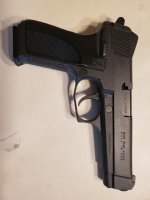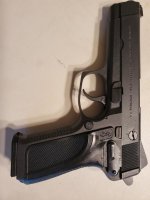The FN HP-DA/ Browning BDA and the Browning BDM, were attempts to create a successor to the Hi Power and neither lasted long.
The FN HP-DA (middle in the picture below) was designed for the M9 service trials in 1983 and obviously lost. It was sold commercially in the standard form as well as in compact and double action only form with a couple stops and starts from 1984 to 1999. It was sold as the Browning BDA in the US and as the FN HP-DA in Europe.
It lacked the feel and refinement of the Hi Power and had a few other design choices that probably didn't help it much such as not sharing the same magazine as the Hi Power.
The Browning BDM (top in the picture above) was designed for the FBI service pistol trials in 1991 and had a couple of features that were unique.
First, it used a mode switch that allowed it to operate in "revolver" mode as a double action only semi-auto pistol, or in a double action/single action decocker equipped semi-auto pistol mode. There was some benefit in terms of easing the transition of revolver carrying officers to a semi-auto pistol.
Second, it had a very thin grip for a double stack 9mm pistol (on the left below), in fact I've never encountered one that was thinner, and that would have had some benefit for concealed carry by agents. However, it also made the pistol feel funny in the hand, so subjectively it was a failure, and on that was noticeable as soon as a potential customer picked it up. Browning also made the BRM, a version without the selector switch that operated in DAO/Revolver mode all the time.
One major flaw is that when operated in SA/DA pistol mode the safety operated backwards - "up" is the fire position. That was the kiss of death for the design in my opinion.
Neither was a success and they were discontinued in 1998.
FN also made the SFS version of the Hi Power (the bottom pistol in the first picture). The SFS stood for "Safety Fast Shooting" and it was an outgrowth of FNs attempt to submit a pistol for the initial XM9 pistol trials. It was rejected as it was not a double action pistol, although it achieved the intended goals, with some advantages.
The design uses a two part hammer where the upper part cocks the lower part, and then is pressed forward to place the pistol on safe. Pressing the hammer forward pops the safety up into the "safe" position, and conversely pressing the safety lever down pops the hammer back into position to fire.
The end result was that the pistol could be carried in condition 1 with the hammer down on a hammer block, so it was drop safe and less scary looking to civilians who would otherwise be nervous seeing someone carrying a pistol with the hammer cocked. I like it for concealed carry as the hammer is down and won't rub on you or print on your shirt, and it's easy to verify the pistol is on safe. And, if you hold your thumb over the back of the hammer when holstering it, you are assured that it will always be on safe when holstering it.
It also wasn't a marketing success, and I got my SFS Hi Power on closeout at about half the price of the regular epoxy finished Hi Power. You can however get the original FN SFS parts as a conversion kit for a Hi Power from Cylinder and Slide. It'll work on any Hi Power and I converted one of my first gen FEG P9 pistols to SFS operation with only minor re-fitting of the SFS slide stop required.




